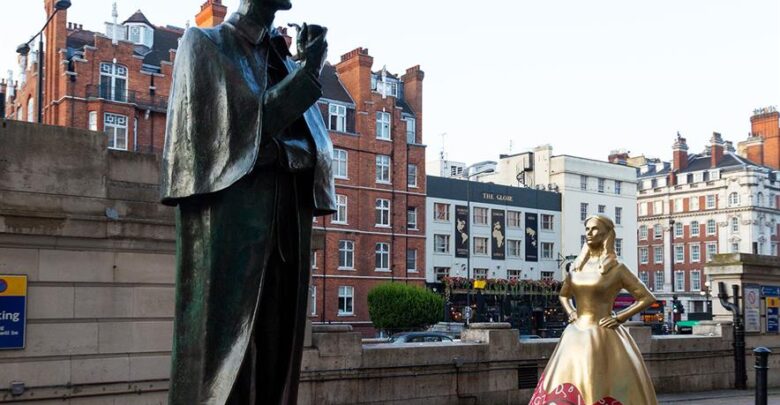Fundamentals of IPIntellectual PropertyIP EnforcementSocial Media and IP
Copyright On Emotions: The Tale Of Holmes

Introduction
Our favourite fictional detective is having too many emotions! Yes, that’s the complaint for which Sherlock Holmes’ writer has challenged the fictional sister, Enola. This new-age family conflict has become the season’s battleground.
A copyright aphorism, “Ideas are not protected, but expressions are” has sparked a heated debate over Holmes, the all-time adonis investigator. Moreover, Conan Doyle’s overreaching extension of copyright to the last tier of character aspects of the sleuth has furthered the demand for misuse of copyright, to be dealt with more stringently, and be considered as an infringement. However, another tier that is attached to Sir Doyle’s argument is the secondary meaning that we all have attached to Holmes. As Holmes himself advised, “it is a capital mistake to theorise before one has data”[1] we must understand the situation before delving into the debates.
Holmes Conflict
Nancy Springer wrote a series of children’s novels called “Enola Holmes,” which were first published in 2006. While these works seemed to have coexisted peacefully with the “Sherlock Holmes” canon for the previous fifteen years, Sir Arthur Conan Doyle’s Estate (hereinafter referred to as ‘Sir Doyle’ or ‘Estate’) has filed a lawsuit in New Mexico district court in response to the announcement of its film adaptation, featuring on Netflix. Both copyright and trademark infringement charges are included in the lawsuit.
Sir Doyle wrote his Sherlock Holmes character in four novels and 56 short tales, the great majority of which are already in the public domain. Six of the most recent pieces, though, will have their copyright expire in 2022. After Netflix’s announcement on purchasing distribution rights in a film based on the “Enola Holmes” book, Estate complained against the adaption of film as well as the book publishers.[2] He claimed that there are fundamental qualities of the character that were established in the later stories, which he penned after returning from war, and are still protected by copyright. According to the complaint, there were certain unexpected artistic decisions that led to Sherlock’s character being evolved into a figure with a heart and a more positive viewpoint. He gained the ability to form friendships, communicate emotion, and appreciate women.
Therefore, essentially, the grievance is that “Enola Holmes” works infringe on Holmes’s version 2.0 since they borrow Conan Doyle’s development of Holmes from cold and critical to warm, courteous, and kind in his interactions.
Moreover, Estate claims that the defendants’ use of the name “Enola Holmes” for a book series and a film, is likely to lead the public to believe that the estate has supported, endorsed, or is otherwise associated with such endeavours under trademark law.
In this case, the parties reached a settlement; however, the case has left behind scope for debate on emotions’ copyrighting as a scuffle, for the Intellectual Property Rights enthusiasts out there.
Copyrighting Emotions
The characters have copyright,[3] including their physical as well as conceptual qualities. In Walt Disney Productions v. Air Pirates,[4] the plaintiff claimed that by making graphic portrayals of over seventeen of the plaintiff’s characters, the defendant exploited them in adult “counter-culture” comic books, infringing on its copyrights. The defendant stated that it was a satirical usage, which constitutes a legal fair use. The Court determined that the defendants copied more of the plaintiff’s works than was required to “conjure up” the parody work, which is not fair use. Hence, this case established that characters in animation or movie format, have physical characteristics and are far more copyrightable than characters in texts. This is due to the fact that novel characters are rarely drawn in the same level of detail as animation or movie characters.
A similar observation was made in Olson v National Broadcasting Co.[5] It stated that copyright protection may be afforded to characters visually depicted in a television series or in a movie for such characters are especially distinctive and impactful. The standard for the same was established in the case of Halicki Films, LLC v Sanderson Sales & Marketing,[6] where it was observed that a character must be “sufficiently delineated” and display “consistent, widely identifiable traits” to be infringing the copyright.
This could be one ground for which Doyle’s estate can claim that Netflix’s series is far more copyright infringing than Springer’s book, as the details of the character in the former are way more impactful than the latter.
However, when a work of literature or a film’s copyright expires, the film’s different components, including the characters and their aspects, fall into the public domain. This was first seen in the case of Silverman v. CBS,[7] in which it was decided that “when a story falls into the public domain, story elements including characters covered by the expired copyright become fair game for follow-on authors”.
In reference to the Holmes case, it must be understood that the character as a whole was protected (before it fell into the public domain) and that the pieces of the character were not independently protected.[8] The character and its emotions are one entity. Despite the fact that the character is in the public domain, the plaintiffs claim ownership of specific components of the character.
It is critical to distinguish between what may be categorised as an idea and what may be defined as an expression in copyright law. An idea might be thinking or a notion that is abstract. It is an expression when thoughts go through a creative process to generate something that can be physically represented. Although ideas cannot be copied, manifestations of those ideas may be.
Having empathy or respect for women is a notion or idea in this situation; however, when it is articulated at numerous places during the narrative, it becomes an expression. At first glance, the way Sherlock Holmes communicates empathy and respect for women may be considered copyrightable as it is an expression. This, however, is a dichotomy in this debate. Certain notions are universal in nature. If they are copyrighted, they will stall the expression as well, and no other author will be able to utilise it in their work.
Therefore, such universal conceptions of a character cannot be separated from it. This was also stated in Nichols v. Universal Pictures Corp.,[9] that the defendant’s ideas were universal conceptions, and hence no infringement occurred. Furthermore, it was stated in Campbell v. Walt Disney Co.[10] that “a cocky and self-reliant attitude,” which are character traits, could not be protected under copyright rules since they are too generic in nature. Moreover, the Court stated in Hogan v. DC Comics[11] that while deciding whether characters are comparable, a Court considers the entirety of the characters’ qualities and features, as well as the amount to which the defendants’ characters capture the overall concept and feel of figures in the plaintiff’s work.
Therefore, in copyrighting emotions, Courts have been examining how central they are to the character’s overall development and whether they are universal and general in nature or not.
Misuse Of Copyright
Another starring issue, in this case, was the misuse of copyright. When copyright holders abuse their limited exclusive rights to control their works outside of the monopoly, it is known as copyright misuse. In the current case, Springer released the book 15 years ago, yet the Doyle Estate took no action against her. In the case of Ontario Inc. v. Shokour,[12] the Court didn’t proceed with a copyright infringement case as it wasn’t filed within the three-year limitation period set out in Section 43.1(1) of the Copyright Act.[13]
Such delay in the filing of a case of copyright infringement has two facets attached to it in the Indian scenario. The case of Roma Mitra v. the State of Bihar,[14] observed that the question of limitation had to be considered from the date of knowledge and, not from the date of commission of the offence. Hence, a delay in filing the case may be considered only if the reasons for the same are reasonable. However, in Ritu Primlani Alias Vasu Primlani v. State Of Karnataka[15], the Court quashed the copyright infringement case due to a delay of 10 years in filing the complaint. Hence, solely based on the limitation period, the estate’s case could have been quashed.
Furthermore, in the current case, when a film based on the book is developed, the estate has awoken its legal consciousness and asserts its copyright (which has already ceased to end). Moreover, Estate, presently, has only six works protected by copyright. In these works, Sherlock Holmes is believed to have established new distinguishing characteristics, including emotional empathy and respect for women. It’s essential to note here that the protection of these characteristics would eventually extend to the Sherlock Holmes Characters, that have already entered the public domain. Without Sherlock, these characters are nothing more than general concepts that are not protected by copyright laws.
Indian & American Stance on Misuse of Copyright
The theory of copyright misuse is yet to be defined; some Courts have upheld the defence on policy grounds, if either an antitrust law has been broken by the plaintiff or the plaintiff abused the copyright in a way that went beyond copyright law’s public policy.
However, because the theory was yet to be expressly recognised or codified by the United States Supreme Court, its boundaries are unknown. According to Justice Scalia in Dastar Corp. v. Twentieth Century Fox,[16] allowing these kinds of restrictions on a public domain work might essentially establish “a kind of mutant copyright law” that would limit the public’s freedom to reproduce and exploit expired copyrights.
The theory prohibits the copyright holder from seeking to extend the copyright’s impact or operation beyond the statutory right’s scope. Therefore, it will not be a stretch to suggest that Doyle Estate’s copyright infringement claim is nothing more than a case of copyright abuse.
The equitable defence of copyright abuse is founded on the notion of unclean hands and is used in situations of copyright infringement. The abuse rule states, in general, that a copyright holder who engages in abusive or inappropriate activity in exploiting or enforcing the copyright would be barred from pursuing their rights against an infringement. It is evident, in the current case, that the Estate was extending the copyright to misuse the final, last tier of monopoly on the work of Holmes.
In India, copyright misuse is not a new concept. In the infamous DU photocopy case,[17] the Court observed that copyright is not a divine right, and it is meant to aid rather than hinder the harvest of knowledge, by sharing information and advancing education.
However, the Delhi High Court in Tekla Corporation & Anr v. Survo Ghosh & Anr.[18] changed the way judiciary and law dealt with misuse of copyright. It rejected the rule of “misuse of copyright” stating that it does not constitute a legitimate defence for copyright infringement in India. When it comes to a conflict between law and equity, the law is at a higher pedestal and the Indian copyright law[19] does not give copyright a conditional right that is only provided if copyright is not misused. Sections 51 and 52[20] which states when copyright may be considered to be infringed and when not, are an exhaustive list of probable claims and defence. Therefore, Section 52[21] contains an entire list of defences, and nothing outside of it may be used as a lawful defence. Further, in the case of a high royalty, the licensee can always contact the authority and request a forced licence. Moreover, even if Copyright Misuse were an equitable remedy, the law of clean hands precludes such a remedy in this case because the defendant committed copyright infringement.
It was also ruled that it was illegal under Section 16[22] because it amounted to granting or denying a person copyright in a way that was not consistent with the Act’s requirements. The Court slammed the theory of misuse of copyright, calling it an amorphous law:
“It is unpalatable to me that an act of the copyright owner, while in law can be a defense to an action by him for infringement, would not furnish an independent cause of action to the affected persons.”[23]
Tekla Corporation & Anr v. Survo Ghosh & Anr. AIR 2014 Delhi 121.
Several principles of law are considered in India when debating on misuse of copyright; however, it has adopted it with a limitation on the rights of copyright holders significantly. Unlike in the United States, the idea of copyright abuse has gained no statutory backing. Thus, as the law is quiet on the subject, the idea of “misuse of copyright” in India, is not considered to be an independent cause for action or defence. Scholars have been pressing on how it should be understood from a policy perspective. They assert that the idea of copyright is to allow writers to create work and be compensated for it as society develops via socio-cultural enrichment.
Hence, while the US court will give credit to the claims of the defendant that the Estate has been making overreaching demands for his last leg of copyrighted work; Indian courts will not claim this demand, based on Tekla’s precedent.[24]
Secondary meaning to Holmes’ legacy
To qualify as a trademark, after distinguishing as copyright, a non-inherently unique mark must be available on the work, to have that level of strength or secondary meaning. Secondary meaning is a psychological function of the symbols or trademarks, such as “attraction,” “drawing power,” or “commercial magnetism.” The basic rule is that an identifying mark is distinctive and protectable if it is either naturally distinctive or has gained distinctiveness. Thus this refers to the process of acquiring individuality. [25]
The Indian Trademarks Act of 1999 through Section 32,[26] rather indirectly, speaks about acquired distinctiveness and secondary meaning. It states that if a mark is registered despite the facts relating to grounds for refusal of registration, it will not be rendered invalid if, as a result of its use, it has acquired a distinctive character in relation to the goods for which it is registered, after registration and before the commencement of any legal proceedings.
In the current debate, the title Enola Holmes, according to Doyle’s Estate, is likely to cause confusion with a collection of Sherlock Holmes-related trademarks owned by Doyle’s Estate, such as “Sherlock Holmes” especially since Doyle’s Estate owns several U.S. trademark registrations in the fields of books, entertainment exhibitions, and electronic gaming.
While book and movie titles and character names are not copyrightable due to the limitation on copyrighting words and short phrases, book and film series characters and titles can be trademarked if a “secondary meaning” can be demonstrated.
In a Walt Disney Company case,[27] it was observed that the audience of the show understood Disney as the source of everything Mickey Mouse. Hence, Mickey Mouse shall continue to be protected under the Lanham Act, even after the first Mickey Mouse publication, Steamboat Willie will fall into the public domain in a few years. Indeed, trademark law provides protection to owners of earlier creative works that have entered the public domain, especially highly drawn characters such as Mickey Mouse or Sherlock Holmes.[28]
Similarly, in the case of Viacom International Inc v. IJR Capital Investments, LLC,[29] the Court observed that while considering a mark to be legally protectable, the ownership, as evidenced by the company’s use of the mark as a source identifier, as well as its uniqueness shall be accounted. The court laid down seven factors that are to be accounted for establishing secondary meaning, which are:
- Length and manner of use of the mark of trade dress;
- The volume of sales;
- Amount and manner of advertising;
- Nature of use of the mark or trade dress in newspapers and magazines;
- Consumer-survey evidence;
- Direct Consumer Testimony; and
- The defendant’s intent in copying the mark.
Hence, the Estate’s claim on the reference to his Estate may be taken up. This is because a secondary meaning has been attached to the reference of “Holmes” with Doyle’s estate, and the audience has started believing that all such references’ content has come from them. Moreover, Sherlock Holmes has created an impactful credit in the people’s mind, making the character copyright in itself.
Conclusion
Cases like Holmes’ conflict have brought back the questions of why do we need copyright laws at all? It is an affirmative defence in a copyright infringement case that one cannot be utilising it as a stand-alone cause of action for damages. To trace the origin and legitimacy of ‘copyright misuse’, one must understand the patent misuse. The parallelism between the aims of copyright and patent laws is defining the monopoly extension. This makes it a public policy component of copyright law. In asserting such a verdict, there is a need to follow a “mean-end” strategy. The “mean” here is the production of work and the author’s incentives, and the “goal” is the advancement of society and socio-cultural enrichment. Most often than not, copyright abuse claims infringe on copyright holders’ rights.
However, in situations like Holmes, it’s imperative to remember the intent of copyright, as well as the meaning that the audience has attached to it. While the intent is to encourage writers to create additional works and advance society, the audience of Holmes has built him as a character in himself, distinctive with feelings, emotions and life. Therefore, the law behind misuse is the ‘why’ behind granting the right under copyright policy whilst also understanding the impact which such copyright has or will cause.
The article can be cited as:
Tannvi, Copyright On Emotions: The Tale Of Holmes, Metacept-Communicating the Law, accessible at, https://metacept.com/copyright-on-emotions:-the-tale-of-holmes/
References
[1] Conan Doyle, A., 1891. A scandal in Bohemia. The Adventures of Sherlock Holmes, pp.5-29.
[2] Conan Doyle Estate Ltd. v. Springer et al 1:2020cv00610.
[3] Nichols v. Universal Pictures Corporation 45 F.2d 119.
[4] Walt Disney Productions v. Air Pirates 345 F. Supp. 108 (N.D. Cal. 1972).
[5] Olson v. National Broadcasting Co., Inc., 855 F.2d 1446 (9th Cir. 1988).
[6] Halicki Films, LLC v. Sanderson Sales and Marketing (9th Cir. 2008) 547 F.3d 1213.
[7] Silverman v. CBS INC. 632 F. Supp. 1344 (S.D.N.Y. 1986).
[8] Mazer v. Stein 347 U.S. 201.
[9] Nichols v. Universal Pictures Corp. 45 F.2d 119 (2d Cir. 1930).
[10] Campbell v. Walt Disney Company 718 F. Supp. 2d 1108 (N.D. Cal. 2010).
[11] Hogan v. DC Comics, 48 F. Supp. 2d 298 (S.D.N.Y. 1999).
[12] Ontario Inc. (c.o.b. International Institute of Travel) v. Shokour, 2017 FC 969.
[13] Copyright Law of the United States (Title 17), Pub. L. No. 94-553, 90 Stat. 2541. U.S.C §§ 43.1, cl. 1 (1976).
[14] Roma Mitra, W/o Dr. (Prof.) N.R. Mitra v. State of Bihar and Dr. (Mrs.) Sutapa Bhattacharya, Criminal Miscellaneous No. 31757 of 2000.
[15] Ritu Primlani Alias Vasu Primlani v. State Of Karnataka, Criminal Petition No. 1886 of 2015.
[16] Dastar Corp. v. Twentieth Century Fox Film Corp., 539 U.S. 23 (2003).
[17] University of Oxford v. Rameshwari Photocopy Service 2016) 160 DRJ (SN) 678.
[18] Tekla Corporation & Anr v. Survo Ghosh & Anr. AIR 2014 Delhi 121.
[19] Indian Copyright Act, Act No. 14 of 1957, INDIAN CODE (1957), Vol. 1.
[20] Indian Copyright Act, Act No. 14 of 1957, INDIAN CODE (1957), Vol. 1, §§ 51; Indian Copyright Act, Act No. 14 of 1957, INDIAN CODE (1957), Vol. 1, §§ 52.
[21] Indian Copyright Act, Act No. 14 of 1957, INDIAN CODE (1957), Vol. 1, §§ 52.
[22] Indian Copyright Act, Act No. 14 of 1957, INDIAN CODE (1957), Vol. 1, §§ 16.
[23] Tekla Corporation & Anr v. Survo Ghosh & Anr. AIR 2014 Delhi 121.
[24] Tekla Corporation & Anr v. Survo Ghosh & Anr. AIR 2014 Delhi 121.
[25] Shane Wax, NETFLIX AND THE CASE OF ENOLA HOLMES, Gottlieb, Rackman & Reisman, P.C., access at grr.com/publications/netflix-faces-infringement-suit-over-enola-holmes/.
[26] The Trade Marks Act, Act No. 47 of 1999, INDIA CODE (1999), §§ 32.
[27] Walt Disney Productions v. Air Pirates 345 F. Supp. 108 (N.D. Cal. 1972).
[28]Sarah Sue Landau, Of the Mouse and Men: Will Mickey Mouse Live Forever?, May 20, 2020, The NYU Journal of Intellectual Property & Entertainment Law (JIPEL), Vol. 9 – No. 2.
[29] Viacom Int’l, Inc. v. IJR Capital Invs., L.L.C., 891 F.3d 178 (5th Cir. 2018).





